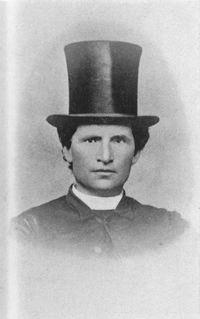
Source: Link
McSPIRITT, FRANCIS, Roman Catholic priest; b. March 1836 in the parish of Templeport, County Cavan (Republic of Ireland); d. 14 Aug. 1895 in Wildfield, Ont.
One of four children of a tenant farmer, Francis McSpiritt received his initial education at St Augustine’s Seminary in Cavan. After spending some time in New York City, he arrived in Toronto in 1861 and on 1 November entered St Michael’s College, where he studied until 1863. He then attended the Grand Séminaire de Montréal until 27 Jan. 1865. Two days later he was ordained at St Michael’s Cathedral in Toronto by Bishop John Joseph Lynch*.
Father McSpiritt would spend the rest of his years serving the diocese of Toronto. His first posting was to Wildfield in the parish of Toronto Gore. He then served in the parishes of Caledon, Niagara Falls, and Adjala before returning in 1887 to Wildfield, where he remained until his death. His priestly career was marked by a reputation for piety and charitable works. A confidant of Archbishop Lynch, he was often asked to rehabilitate fellow clergy with disciplinary or alcohol-related problems. He also made his mark as a “brick and mortar priest,” having been responsible for the building of the rectory in Caledon in 1868 and the construction of St Patrick’s Church in Wildfield in 1894. It was, however, as a faith-healer that he gained his greatest fame. He looked the part, with piercing eyes and a top hat that exaggerated his 5-foot 8-inch height. He also carried a buggy whip, which he was not reluctant to use on wife-beaters or insolent youths who he felt deserved it.
His faith-healing began almost immediately after his first appointment, and in each case cures were effected in return for a specific pledge. For Catholics, this meant undertaking some religious duties. For Protestants, conversion to Catholicism was usually the quid pro quo. Some of the tales are rather macabre. In one case McSpiritt cured a farm couple’s son of epilepsy in return for their pledge to abstain from eating meat on Fridays. According to local folklore, when they did not keep their part of the bargain, the child experienced a seizure while swimming and drowned. Most tales, however, were much more pleasant: they relate cures of migraine headaches and cataracts as well as accident victims and crippled children.
The church’s reaction was first to ignore McSpiritt. About 1885, however, Archbishop Lynch personally asked him to refrain from “thaumaturgic exhibitions” for fear of bringing ridicule upon Catholicism. McSpiritt argued that he was simply God’s instrument and had no control of the powers. Despite the hierarchy’s embarrassment, the public was convinced; in the early 1890s pilgrimages to Wildfield for an audience with McSpiritt were quite common.
McSpiritt reputedly made two predictions shortly before he died. The first was that he would not live to hear the bells of the newly erected parish church; the second that soil from his gravesite applied to diseased parts of the body would effect a cure. Despite the frantic efforts of workmen, the bells did not ring for the first time until the priest’s funeral. After his death the pilgrimages continued, and as late as the summer of 1936 cures from the soil were being claimed. However, the shrine-like tombstone erected in 1895 was replaced by a flat gravestone that rests unobtrusively with several others under a row of pine trees.
ARCAT, E. J. Kelly, “Biographical notes on clergy”; L. UCC-C, Perkins Bull coll. Catholic Record (London, Ont.), July–August 1895. Catholic Register (Toronto), 14 March 1894–22 Aug. 1895. W. P. Bull, From Macdonell to McGuigan: the history of the growth of the Roman Catholic Church in Upper Canada (Toronto, 1939). G. J. Stortz, “The Catholic priest in rural Ontario, 1850–1900,” Religion and rural Ontario’s past: proceedings of the fifth annual Agricultural History of Ontario Seminar, ed. A. A. Brookes (Guelph, Ont., 1980), 32–51. G. S. Tavender, From this year hence, a history of the township of Toronto Gore, 1818–1967 (Brampton, Ont., 1967). Toronto Daily Star, 5 July 1936.
© 1990–2024 University of Toronto/Université Laval
Image Gallery


Cite This Article
Gerald J. Stortz, “McSPIRITT, FRANCIS,” in Dictionary of Canadian Biography, vol. 12, University of Toronto/Université Laval, 2003–, accessed April 17, 2024, http://www.biographi.ca/en/bio/mcspiritt_francis_12E.html.
The citation above shows the format for footnotes and endnotes according to the Chicago manual of style (16th edition). Information to be used in other citation formats:
| Permalink: | http://www.biographi.ca/en/bio/mcspiritt_francis_12E.html |
| Author of Article: | Gerald J. Stortz |
| Title of Article: | McSPIRITT, FRANCIS |
| Publication Name: | Dictionary of Canadian Biography, vol. 12 |
| Publisher: | University of Toronto/Université Laval |
| Year of publication: | 1990 |
| Year of revision: | 1990 |
| Access Date: | April 17, 2024 |







